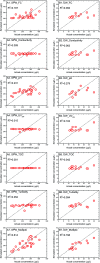Environmental occurrence and risk assessment of haloacetic acids in swimming pool water and drinking water
- PMID: 35519123
- PMCID: PMC9055658
- DOI: 10.1039/d0ra02389b
Environmental occurrence and risk assessment of haloacetic acids in swimming pool water and drinking water
Abstract
A prevalent group of disinfection by-products (DBPs), i.e., haloacetic acids (HAAs), have raised significant public concern due to their high frequency of occurrence, considerable concentrations and potent toxicity. This study investigated the environmental occurrence of HAAs and the corresponding predicted human exposure to two important water matrices where humans are frequently and long-term exposed, i.e., swimming pool waters (SPWs) and drinking waters (DWs), in Shanghai, China. The sum of five HAAs in SPWs was 241 μg L-1 on average (dominated by dichloroacetic acid (DCAA) and trichloroacetic acid (TCAA)), four times as much as its maximum contaminant level (MCL) regulated by the Environmental Protection Agency (EPA) in DWs. The maximum HAA concentration in DWs was 35 μg L-1, with chloroacetic acid (CAA) as the most dominant compound. The higher concentrations (reflected by total organic carbon (TOC), dissolved organic carbon (DOC), and UV254) and more categories (body fluids and personal care products in addition to natural organic matter) of organic contaminants and the higher chlorine in SPWs should be responsible for the differentiated HAA yield and speciation. The qualification rates of samples have been evaluated. The power function models correlating HAAs with multiple water quality parameters were developed with correlation coefficients of 0.614 and 0.798 for SPWs and DWs respectively. These models may provide the preliminary insights on how to minimize HAA formation by grasping the relative importance of each parameter and how to build the framework to predict HAA formation in untreated source water or SPWs subjected to chlorination. The predicted carcinogenic and non-carcinogenic risks of humans exposed to SPWs and DWs with HAAs were within the acceptable levels.
This journal is © The Royal Society of Chemistry.
Conflict of interest statement
There are no conflicts of interest to declare.
Figures



Similar articles
-
Mammalian cell cytotoxicity and genotoxicity of the haloacetic acids, a major class of drinking water disinfection by-products.Environ Mol Mutagen. 2010 Oct-Dec;51(8-9):871-8. doi: 10.1002/em.20585. Environ Mol Mutagen. 2010. PMID: 20839218
-
Formation of haloacetic acids from different organic precursors in swimming pool water during chlorination.Chemosphere. 2020 May;247:125793. doi: 10.1016/j.chemosphere.2019.125793. Epub 2019 Dec 31. Chemosphere. 2020. PMID: 31931310
-
Characterization of disinfection byproduct formation potential in 13 source waters in China.J Environ Sci (China). 2011;23(2):183-8. doi: 10.1016/s1001-0742(10)60440-8. J Environ Sci (China). 2011. PMID: 21516990
-
Regulation, formation, exposure, and treatment of disinfection by-products (DBPs) in swimming pool waters: A critical review.Environ Int. 2018 Dec;121(Pt 2):1039-1057. doi: 10.1016/j.envint.2018.10.024. Epub 2018 Nov 2. Environ Int. 2018. PMID: 30392941 Review.
-
Occurrence, origin, and toxicity of disinfection byproducts in chlorinated swimming pools: An overview.Int J Hyg Environ Health. 2017 May;220(3):591-603. doi: 10.1016/j.ijheh.2017.01.005. Epub 2017 Jan 30. Int J Hyg Environ Health. 2017. PMID: 28174041 Review.
Cited by
-
Robust immobilization of anionic silver nanoparticles on cellulose filter paper toward a low-cost point-of-use water disinfection system with improved anti-biofouling properties.RSC Adv. 2021 Jan 25;11(9):4873-4882. doi: 10.1039/d0ra09152a. eCollection 2021 Jan 25. RSC Adv. 2021. PMID: 35424442 Free PMC article.
-
Study on the Combined Toxicities and Quantitative Characterization of Toxicity Sensitivities of Three Flavor Chemicals and Their Mixtures to Caenorhabditis elegans.ACS Omega. 2021 Dec 13;6(51):35745-35756. doi: 10.1021/acsomega.1c05688. eCollection 2021 Dec 28. ACS Omega. 2021. PMID: 34984305 Free PMC article.
References
-
- Andersen B. M., Prevention and Control of Infections in Hospitals, Springer, 2019, pp. 815–834
-
- Galeano L.-A., Guerrero-Flórez M., Sánchez C.-A., Gil A. and Vicente M.-Á., Applications of Advanced Oxidation Processes (AOPs) in Drinking Water Treatment, Springer, 2017, pp. 257–295
-
- Richardson S. D. Plewa M. J. Wagner E. D. Schoeny R. Demarini D. M. Occurrence, genotoxicity, and carcinogenicity of regulated and emerging disinfection by-products in drinking water: a review and roadmap for research. Mutat. Res. 2007;636:178–242. - PubMed
LinkOut - more resources
Full Text Sources
Research Materials

